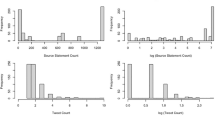Abstract
The crux to emergency management is public opinion control, while the key to public opinion control is the control of online spread of information about emergencies, premised on the study of online information flow about emergencies in order to effectively warn against and channel emergencies and prevent the spread and deterioration of information about a crisis in the spread of such information. Based on the complex network theory, information spread theory and disease spread theory, as well as a study of the Wenling doctor murdering case, a model about the spread of information on emergencies is constructed by combining empirical data and simulation experiments. Through the verification and analysis of the simulation results, the rationality of the model and the simulation results is proved, thus providing an approach of modeling and analysis that can be used for reference in subsequent research on the spread of information about emergencies through multi-information spread sources. This research has certain reference value for establishing an information spread control and guidance mechanism.
















Similar content being viewed by others
References
Severin WJ, Tankard JW (1988) Communication theories: origins, methods, uses. Longman, New York
Zhao J, Sun N (2020) Government subsidies-based profits distribution pattern analysis in closed-loop supply chain using game theory. Neural Comput Appl 32:1715–1724
Zhang L (2009) Research on social network structure and dynamics of crisis information. A Dissertation for Doctor’s Degree, University of Science and Technology
Xue K, Xu GP, Zhang Y, Zhao YJ (2018) How does the micro-blog public crisis information transmission order affect the forwarding behavior? Based on SMCC and ICTS theoretical interpretation and experimental analysis. Inf Sci 36(09):82–88
Meng L, Kang Q, Han C et al (2016) A multi-agent model for simulation of public crisis information dissemination. Int J Wirel Mob Comput 11(1):33–41
Zhihong Li, Jile He, Pengfei Wu (2007) The time period characteristic of information communication model and its management strategies of paroxysmal public crisis. Libr Inf Serv V51(10):88–99
Zhang L, Zhong Q, Qi W (2009) Two-stage dynamics of crisis information dissemination on social network. In: International conference on management science and engineering
Liu L, He H, Wang Y et al (2012) Modeling and analyses of information dissemination of emergency events in social network. Adv Sci 4:365–370
Stauffer D (2002) Sociophysics: the Sznajd model and its applications. Comput Phys Commun 146:93–98
Stauffer D (2003) Sociophysics simulations. Comput Sci Eng 5(3):71–75
Yan W, Zhang H (2012) Research on opinion dynamics model for online review. J Beijing Univ Posts Telecommun (Soc Sci Ed) 14(4):9–15
Wei J, Bu B, Guo X et al (2014) The process of crisis information dissemination: impacts of the strength of ties in social networks. Kybernetes 43(2):178–191
Liu X, He D, Liu C (2019) Information diffusion nonlinear dynamics modeling and evolution analysis in online social network based on emergency events. IEEE Trans Computat Soc Syst 6:8–19
Yu L, Li L, Tang L et al (2017) A multi-agent-based online opinion dissemination model for China’s crisis information release policy during hazardous chemical leakage emergencies into rivers. Online Inf Rev 41(4):537–557
Acknowledgements
This work was supported by the Shanghai Natural Science Foundation (19ZR1435600), the Natural Science Fostering Foundation (1F-19-303-001), the National Natural Science Fund (71801150) and the Shanghai Sports Social Science Research Foundation (TYSKYJ201915).
Author information
Authors and Affiliations
Corresponding author
Ethics declarations
Conflict of interest
None.
Additional information
Publisher's Note
Springer Nature remains neutral with regard to jurisdictional claims in published maps and institutional affiliations.
Rights and permissions
About this article
Cite this article
Zhao, Jh., Zeng, Dl., Qin, Jt. et al. Simulation and modeling of microblog-based spread of public opinions on emergencies. Neural Comput & Applic 33, 547–564 (2021). https://doi.org/10.1007/s00521-020-04919-2
Received:
Accepted:
Published:
Issue Date:
DOI: https://doi.org/10.1007/s00521-020-04919-2




